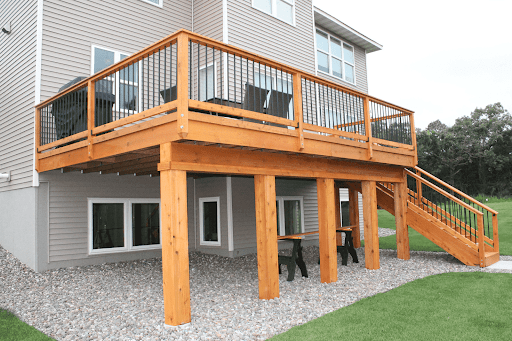Building a new deck is exciting, but choosing the right footings and foundation is where it all begins. Without a strong base, your deck could shift, crack, or even collapse over time. The footing is what keeps your deck safe, level, and standing tall through all kinds of weather.
Don’t worry; you don’t need to be a pro to get it right. In this guide, we’ll walk you through everything you need to know about footings and foundations for your deck. Whether you’re dreaming of a small backyard getaway or a large party spot, we’ll help you choose the best support for your space.
Understand Your Deck’s Purpose and Size
Choosing the right footings and foundation for your new deck begins with understanding your deck’s purpose and size. This step is crucial, as the way you plan to use your deck and its size directly impact the type of support required.
For the best results, it’s a good idea to consult with experienced deck construction contractors who can help ensure your foundation is strong and safe.
Why Purpose Matters
Before you start building, ask yourself: What will I use my deck for? Is it just for sitting and relaxing, or will it hold heavy things like a hot tub, a grill, or lots of furniture? Maybe you want a space for family gatherings or parties with lots of people.
Different uses mean different loads on your deck. The heavier the use, the stronger your footings and foundation need to be.
Size Makes a Difference
Next, think about the size of your deck. A small deck for a few chairs doesn’t put as much weight on the ground as a large deck designed for big groups. The bigger the deck, the more weight it must carry, so it needs stronger or deeper footings to keep it safe and stable.
How to Match Footings to Your Deck
If you’re building a small deck for light use, simple footings like deck blocks or shallow piers may be enough. But for bigger decks or ones with heavy items, you’ll want stronger foundations like poured concrete piers that go deeper into the ground. This helps keep the deck steady and prevents it from sinking or shifting.
Understanding your deck’s purpose and size helps you choose the right footings and foundation, making sure your deck is safe, stable, and built to last. Taking the time to plan this correctly saves you headaches and repairs down the road.
Know Your Soil and Location
When choosing the right footings and foundation for your new deck, it’s important to know your soil and location. The type of soil beneath your deck and the weather where you live will affect how strong and deep your footings need to be.
Why Soil Type Matters
Different soils behave differently. Sandy soil drains water quickly but doesn’t hold weight well, which means your footings might need to be deeper or stronger to keep the deck stable. Clay soil holds water and can expand or shrink with changes in moisture, which can cause your deck to shift if the footings aren’t properly set. Rocky soil is solid but can make digging footings harder.
How Weather and Climate Affect Footings
Your location’s climate also plays a big role. If you live in a place where the ground freezes in winter, your footings need to go below the frost line. This prevents them from moving when the soil expands and contracts with freezing and thawing. In wet or rainy areas, proper drainage around footings is important to keep water from pooling and damaging the foundation.
What to Do Before You Build
Before you dig, check your soil type and learn about your local weather conditions. You can get a soil test or talk to local experts for advice. Knowing this information helps you pick footings that will hold up over time.
Pick the Right Type of Footings

Choosing the right footings and foundation for your new deck is key to making sure it stands strong and safe. Footings are what support your deck’s weight and keep it steady, so picking the right type is important.
Common Types of Footings
There are several types of footings to consider. Concrete piers are poured into the ground and are very strong. They work well for bigger decks or decks that will hold heavy items like hot tubs or grills. Deck blocks are easier to use and are great for smaller decks.
They sit on the ground or just slightly buried and don’t require much digging. Helical piles, which are like big metal screws, are a good choice if your soil is tricky or you need extra strong support without digging deep holes.
Match Footings to Your Deck’s Needs
The size and purpose of your deck will help you decide which footing to choose. For light-use decks, deck blocks or shallow piers might be enough. For decks that will hold a lot of weight or be used often, deeper and stronger footings like concrete piers or helical piles are better.
Consider Cost and Installation
Also think about your budget and how much work you want to do yourself. Deck blocks are usually cheaper and easier to install, while concrete piers take more time and effort but offer better long-term stability.
When to Ask for Help
If you’re not sure which footing is best, it’s a good idea to get advice from a professional. Choosing the right footing keeps your deck safe, sturdy, and built to last through many seasons.
Follow Local Building Codes
When choosing the right footings and foundation for your new deck, following local building codes is essential. Building codes are rules set by your city or county to make sure your deck is safe, strong, and built the right way.
Why Building Codes Matter
Building codes tell you important details like how deep your footings should be, what materials to use, and how far your deck must be from property lines or other structures. Following these rules helps prevent problems like your deck shifting, collapsing, or causing damage to neighboring properties.
Getting Permits
Before you start building, you usually need to get a building permit. This is an official approval from your local government that lets you build your deck legally. The permit process often includes inspections to make sure your deck is being built safely and up to code.
Avoiding Problems
Ignoring building codes can cause big issues, including fines or even having to tear down your deck. It’s better to do things right the first time. If you’re unsure about the rules or the permit process, you can ask your local building office or hire a professional to help.
Conclusion
Choosing the right footings and foundation for your new deck doesn’t have to be hard. With the right info and a little planning, you’ll build a deck that’s safe, strong, and lasts for years. Take it step by step, and soon you’ll be relaxing on your perfect backyard deck.









